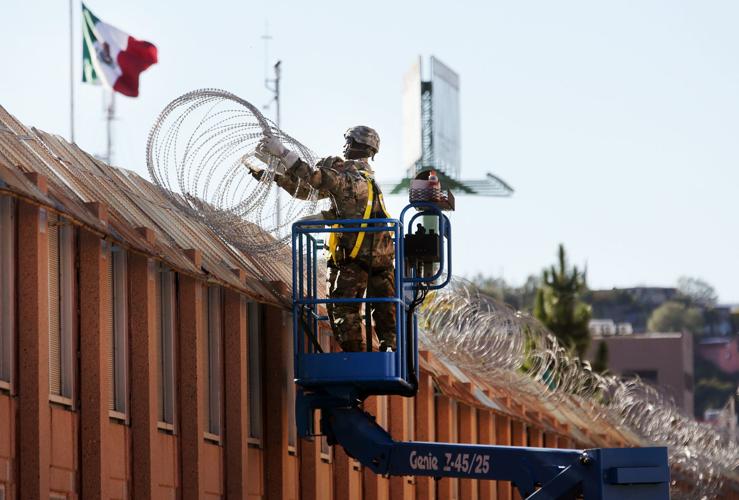NOGALES, Ariz. — In border towns like Nogales, people are used to being misunderstood.
One bad thing happens, maybe even in the Mexican city across the border by the same name, and that colors the outside world’s opinion of the American border town for years. Or sometimes nothing at all happens, and a national furor still breaks out about an alleged border crisis that they can’t see despite living right there where it is supposedly happening.
That latter, absurd situation is what created the spectacle this week of U.S. Army soldiers working along the border wall east of the downtown DeConcini port of entry. The soldiers, part of President Trump’s deployment of, so far, 5,600 troops, started stringing concertina wire atop a stretch of border wall perhaps 250 yards long on Tuesday.
On Thursday, when I visited, some soldiers were stringing a second strand of wire below the first, along the same stretch of wall. If you know Nogales, or the border in general, the scene was exactly what you’d expect this time of year: Sunny, pleasant and quiet. When I was there Thursday morning, 15 to 20 soldiers were there, a couple of them operating a boom lift while a few others helped raise the strings of concertina wire or direct the action from below.
The remaining soldiers were arguably occupied. A few military police officers stood with their backs to the operation and looked outward at the empty street in case any threats emerged. Suffice it to say none did.
Staff Sgt. Ariele Tejada, of a Washington-based public affairs unit, did a video interview of Private First Class Grant Rasmussen, a member of the 104th Engineering Company based in Texas. A few other soldiers clustered in the shade of the Morley pedestrian crossing, looking at their phones as others leaned against the border wall looking bored.
This is what you get when you send soldiers to a nonexistent crisis.
It was actually relaxing to watch the slow movement of the Genie boom lift, and a little funny in an absurd way, but it didn’t have the feeling of an important activity for national security. That’s probably because it is not. An Army deployment is not a logical response to the migrant caravans in Central America and Mexico. Bolstering the asylum system and immigration courts would be, but it would not produce any politically beneficial pictures or stories about soldiers on the border.
Evan Kory, whose family owns the nearest shop to the stretch of wall where the soldiers were working, was shocked and disturbed when he saw them arrive, in particular because it was Election Day. And the deployment felt like an election ploy by President Trump.
“It’s already a very heavily patrolled area with the Border Patrol. To see suddenly dozens of people in military uniform was very shocking,” Kory said.
“I don’t have any ill feelings toward them. They’re just following orders, and the people giving the orders aren’t thinking this through.”
That’s a generous conclusion. People who live in border towns are used to distant authorities not thinking through their actions at the border. But I suspect they did think this deployment through, and the fact that it didn’t make practical sense is not relevant.
The deployment, or increased vigilance at ports of entry in recent days and weeks, seems to be hurting the shops’ business, employees told me. People who were crossing the Morley pedestrian gate when I was there had waited anywhere from 30 to 90 minutes, a discouragingly long time.
Jaime Muñoz, who works at a shop catering to law-enforcement officers called Nogales Tactical, told me the delays at the crossings are killing business. They are also costing him extra hours of his life as he crosses daily from Nogales, Sonora.
Lourdes Martinez, working at a nearby optical shop, told me increased border vigilance has played havoc with her schedule. She takes her son to her mother’s house on the Mexican side while she works, but the waits to drive back into the U.S. have taken her up to 3 1/2 hours. She arrived late to work on Monday, and her boss sent her home. There was no business and no need for her.
Maybe the soldiers could somehow be used to ease the congestion at border crossings? Now that would make sense.
As I pondered the concertina wire and local residents’ dismissive attitude, I thought maybe residents of the West International Street neighborhood, just west of downtown Nogales along the border, might have a more receptive attitude.
This is the neighborhood where young smugglers were taking marijuana across the fence back in October 2012, when Border Patrol agent Lonnie Swartz shot and killed a teen in Mexico who had thrown rocks over the fence. Swartz is on trial for manslaughter in Tucson’s federal court now, and the jury was taken to the border site Wednesday night.
So I walked the neighborhood and interviewed a half-dozen people, asking if they wouldn’t mind if concertina wire were installed atop their stretch of fence — not that the Army is proposing to do so. It was just a hypothetical question.
Their responses were consistent: Sometimes people jump the tall fence there, but the neighborhood is quiet anyway, and they wouldn’t care if the military topped the fence with wire. They doubt it would have any effect anyway. In one Mexican phrase, I’d summarize it as “ni modo” — or “whatever.”
Cesar Velasquez, who told me he has lived about a year on Hereford Street, laughed dismissively as he prepared to drive away with his young daughter.
“I don’t care ‘cause they’re still going to find a way through. Border Patrol’s always here, and they still get through,” he said. “I just don’t see the point.”
It’s past Election Day now, and as soldiers continue to filter into border deployments, I suspect more residents and even many of the soldiers themselves will start to have the same feeling. “I just don’t see the point.”
But that’s how it is when you live in a region misunderstood by voters and authorities thousands of miles away. Ni modo.
Column edited to clarify circumstances of cross-border shooting in October 2012.







